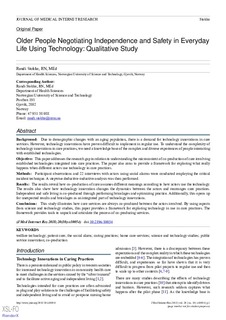| dc.contributor.author | Stokke, Randi | |
| dc.date.accessioned | 2019-01-29T11:51:28Z | |
| dc.date.available | 2019-01-29T11:51:28Z | |
| dc.date.created | 2018-10-22T08:44:20Z | |
| dc.date.issued | 2018 | |
| dc.identifier.citation | Journal of Medical Internet Research. 2018, 20 (10), . | nb_NO |
| dc.identifier.issn | 1438-8871 | |
| dc.identifier.uri | http://hdl.handle.net/11250/2582797 | |
| dc.description.abstract | Background: Due to demographic changes with an aging population, there is a demand for technology innovations in care services. However, technology innovations have proven difficult to implement in regular use. To understand the complexity of technology innovations in care practices, we need a knowledge base of the complex and diverse experiences of people interacting with established technologies.
Objective: This paper addresses the research gap in relation to understanding the microcontext of co-production of care involving established technologies integrated into care practices. The paper also aims to provide a framework for exploring what really happens when different actors use technology in care practices.
Methods: Participant observations and 22 interviews with actors using social alarms were conducted employing the critical incident technique. A stepwise deductive-inductive analysis was then performed.
Results: The results reveal how co-production of care assumes different meanings according to how actors use the technology. The results also show how technology innovation changes the dynamics between the actors and rearranges care practices. Independent and safe living is co-produced through performing bricolages and optimizing practice. Additionally, this opens up for unexpected results and bricolages as an integrated part of technology innovations.
Conclusions: This study illustrates how care services are always co-produced between the actors involved. By using aspects from science and technology studies, this paper provides a framework for exploring technology in use in care practices. The framework provides tools to unpack and articulate the process of co-producing services. | nb_NO |
| dc.language.iso | eng | nb_NO |
| dc.publisher | Journal of Medical Internet Research | nb_NO |
| dc.rights | Navngivelse 4.0 Internasjonal | * |
| dc.rights.uri | http://creativecommons.org/licenses/by/4.0/deed.no | * |
| dc.title | Older people negotiating independence and safety in everyday life using technology: Qualitative study | nb_NO |
| dc.title.alternative | Older people negotiating independence and safety in everyday life using technology: Qualitative study | nb_NO |
| dc.type | Journal article | nb_NO |
| dc.type | Peer reviewed | nb_NO |
| dc.description.version | publishedVersion | nb_NO |
| dc.source.pagenumber | 12 | nb_NO |
| dc.source.volume | 20 | nb_NO |
| dc.source.journal | Journal of Medical Internet Research | nb_NO |
| dc.source.issue | 10 | nb_NO |
| dc.identifier.doi | 10.2196/10054 | |
| dc.identifier.cristin | 1622074 | |
| dc.description.localcode | © Randi Stokke. Originally published in the Journal of Medical Internet Research (http://www.jmir.org), 19.10.2018. This is an open-access article distributed under the terms of the Creative Commons Attribution License (https://creativecommons.org/licenses/by/4.0/) | nb_NO |
| cristin.unitcode | 194,65,70,20 | |
| cristin.unitname | Senter for omsorgsforskning | |
| cristin.ispublished | true | |
| cristin.fulltext | original | |
| cristin.qualitycode | 2 | |

